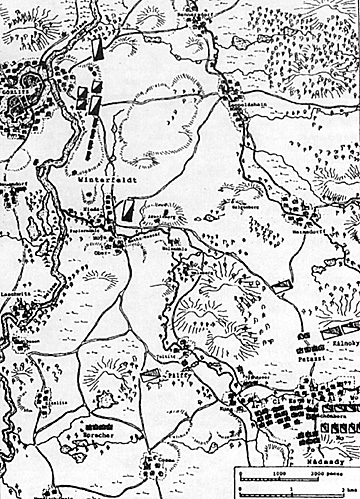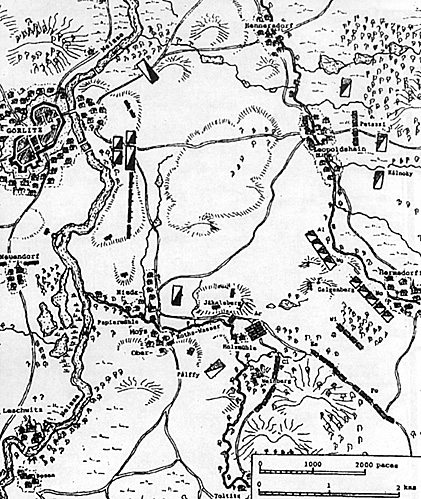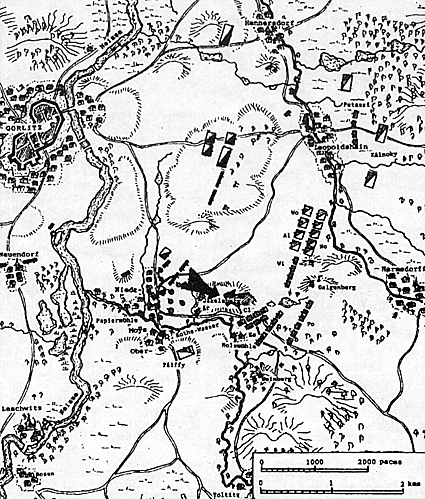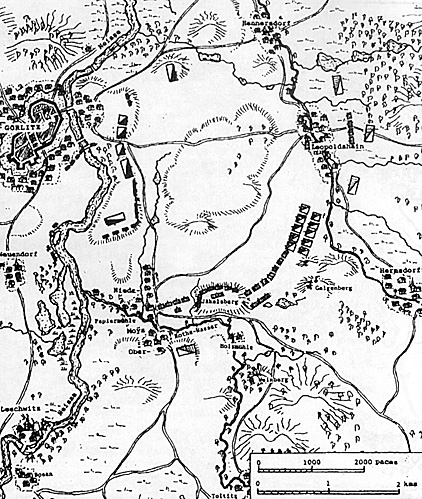 Finally the Imperial and Royal army decides to attack the Corps of General Winterfeldt on the right bank of the Neisse.
In constructing the map of the ensuing combat I have drawn upon those published by Raspe and d'Heulland to supplement that given by St Paul.
Finally the Imperial and Royal army decides to attack the Corps of General Winterfeldt on the right bank of the Neisse.
In constructing the map of the ensuing combat I have drawn upon those published by Raspe and d'Heulland to supplement that given by St Paul.
7 a.m. on the right bank of the Neisse.
SEPTEMBER 7th (continued)
His Royal Highness had resolved to attack General Winterfeldt. The attack followed a plan concerted between Brigadier Montazet and Generals Nadasdy, Graf Colloredo and the Duke of Arenberg. Orders were accordingly issued to the Reserve Corps and to the Corps of General Nadasdy, who were joined by the 16 companies of grenadiers under the orders of General Sprecher. These troops marched during the night at 1 o'clock.
General Graf von Colloredo had a fall from his horse yesterday that prevented from marching with the Reserve Corps. The command of that corps devolved upon the Duke of Arenberg, who acquitted himself with distinction. Several people in the army reflect upon the fortuitous nature of this fall; loftily, they say that it could not have had a better outcome than to keep in the rear a general who is too old for action.
Towards 6 o'clock in the morning, finding themselves within range of the Prussians, these troops started to form in two lines. The cavalry, on the right wing, rested on the village of Hermsdorff. The grenadiers, on the left, extended to the mill at Moys, which is on the RothsWasser. General Nadasdy divided the Croats into three corps: that of the right occupied the villages of Hermsdorff and Leopoldshain; the next preceded of the grenadiers on the left wing; and, the third deployed beyond the Roths-Wasser, where it was to attack the wood and the village of Moys supported by two regiments of hussars and several companies of grenadiers.
First Attack
 The Austrians columns advanced along hollow ways, through countryside covered by woods and ravines. Because of their fear of desertion, the Prussians held their troops close to their camp. Thus, they saw nothing other than the Croats and hussars; the Prussians supposed this to be nothing other than foragers from the Corps of Nadasdy. The Prussians contented themselves with firing a few cannon shots at them and ordering the troops encamped on the height called the Jttkelsherg to take up their arms. Those troops did not even strike their tents. Soon alter, when they saw the Austrian infantry in the plain, they perceived their error.
The Austrians columns advanced along hollow ways, through countryside covered by woods and ravines. Because of their fear of desertion, the Prussians held their troops close to their camp. Thus, they saw nothing other than the Croats and hussars; the Prussians supposed this to be nothing other than foragers from the Corps of Nadasdy. The Prussians contented themselves with firing a few cannon shots at them and ordering the troops encamped on the height called the Jttkelsherg to take up their arms. Those troops did not even strike their tents. Soon alter, when they saw the Austrian infantry in the plain, they perceived their error.
First assault, 11am
Then the Austrian cannon began to play. The Croats of the left followed by the grenadiers, led by The Duke of Arenberg and Brigadier de Montazet, scaled the height. There they turned the entrenchment, which was open at the gorge; and they put to flight those who defended it. They then took possession of the camp of the three battalions who had held the Jakelsberg capturing three cannon and a color.
Simultaneously, the Croats beyond the Roths-Wasser attacked the wood and the village of Moys, which they carried at the first onset. The Hussar Regiment Nadasdy, who followed them, captured three Colours.
At the moment the attack commenced, the Prussian generals were at the Headquarters of General Winterfeldt. The rushed to their brigades, set the troops in order, and, marching by their right in columns, they attacked the Croats and grenadiers who had taken possession of the height. By the superiority of their fire, the Prussians obliged the Croats and grenadiers to abandon the first height and fall back upon the infantry and artillery that was still clambering up the slopes.
The grenadiers started to retire and they were in some disorder. Then, with excellent timing, the Infantry Regiments Ligne, Arberg, Platz, Sprecher and Sax-Gotha came to their aid. They immediately drove off the Prussians once more, not only from the camp but as far as the foot of the Jakelsberg.
 Second Attack
Second Attack
In this second attack, the Austrians captured three Colours and a 16-pounder cannon. They also captured Major-General Kannacher, a lieutenant-colonel and several others officers. Amongst the prisoners was Major of Infantry Graf von Anhalt-Dessau. lie had expected little compassion from the Croats into whose hands he fell; in the hope of saving his life, he had claimed that he was the brother of the King of Prussia.
Crisis on the Jakelsberg, 1pm.
Whilst this was going on, the Prussians, who had formed up near Leopoldshain and attacked the Croats in that village; but those troops held steady under heavy cannon fire for the hour that the attack lasted. Seeing that their efforts were useless, the Prussians retired onto the heights alongside the Neisse in front of the town of Gorlitz. There, they were supported by the fire of batteries from the far side of the river.
The Austrians had never been any intention of engaging in a general action. They had no wish to risk losing the advantage that they had so far gained; nor had they any desire to take on the main body of the Prussian army, from which they believed that the Prince of Bevern had already sent 6 battalions of reinforcements. Thus, they limited themselves to maintaining their position on the Jakelsberg, or Holzberg as it is also called. There, they established the grenadiers in several lines together with such cannon as the nature of the ground would allow. The action then reduced to a cannonade, which lasted until 5 o'clock in the afternoon.
At 4 o'clock in the afternoon 31 companies of foot grenadiers and 8 companies of horse grenadiers from the main body crossed the Neisse to reinforce the Reserve Corps.
 We do not yet know the numbers of dead and wounded. We judge, however, that this day has cost the Prussians about 1,500 men, amongst which there are 200 prisoners, which total does not include the wounded, and 380 deserters. It is said that General Winterfeldt has been killed.
We do not yet know the numbers of dead and wounded. We judge, however, that this day has cost the Prussians about 1,500 men, amongst which there are 200 prisoners, which total does not include the wounded, and 380 deserters. It is said that General Winterfeldt has been killed.
On the Austrian side, no general has been killed, but the dead include several persons of distinction. Amongst the latter are Captains Comle de Grosbec and the Vicomte de Ham of Infantry Regiment Ligne and the Marquis d'Asque, Captain-of-Grenadiers of Regiment Sax-Gotha. Colonel Freiherr von Elrichshausen of Infantry Regiment Sprecher is dangerously wounded; and Captain-of-Grenadiers d' Iftier of Los-Rios suffered a broken arm. General Nadasdy received a light contusion. Lieutenant-General the Marquis di Clerici has two wounds, of which one is on the head; happily, neither should be dangerous.
During the day, the house where Graf von Bentinck, a volunteer, had his lodgings in the village of Schonau was burned as were several barns, stables and so forth. In this fire, he lost a large part of his equipages and eleven horses, of which five were extremely fine riding horses.
End of combat, 5pm.
Journal of Horace St. Paul 1757 Part 5 The Combat at the Jakelsberg
September 7, 1757
September 8, 1757
September 9, 1757
September 10, 1757
September 11, 1757
September 12, 1757
September 13, 1757
Jumbo Camp at Schomberg Map (extremely slow: 350K)
Jumbo Camp at Lauban Map (extremely slow: 342K)
More Journal of Horace St. Paul 1757
-
Part 1: Introduction (June 30-July 14)
Part 2: Introduction (July 15-July 25)
Part 3: Introduction (July 26-August 19)
Part 4: August 20-September 7)
Back to Seven Years War Asso. Journal Vol. XII No. 2 Table of Contents
Back to Seven Years War Asso. Journal List of Issues
Back to Master Magazine List
© Copyright 2001 by James J. Mitchell
This article appears in MagWeb (Magazine Web) on the Internet World Wide Web.
Other articles from military history and related magazines are available at http://www.magweb.com